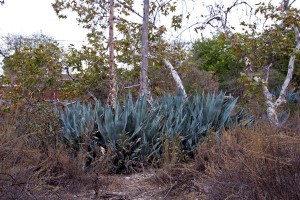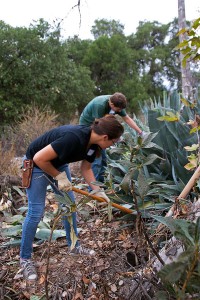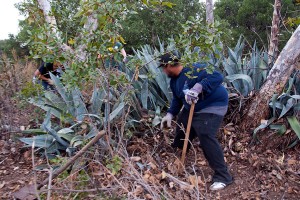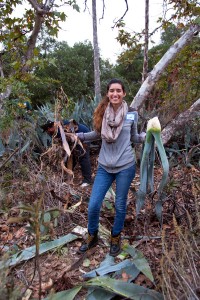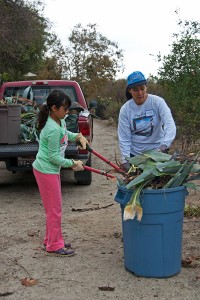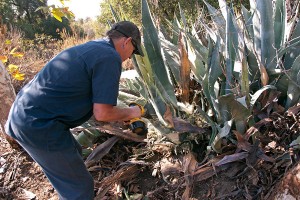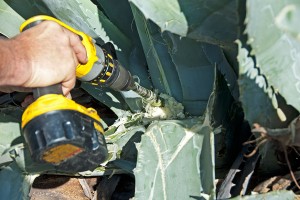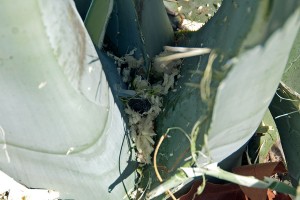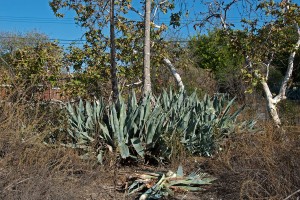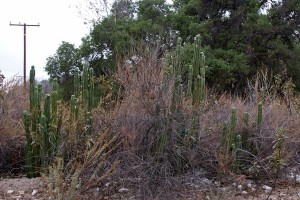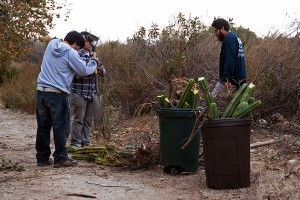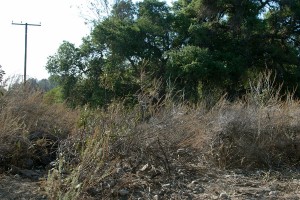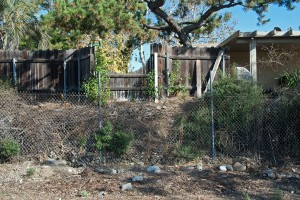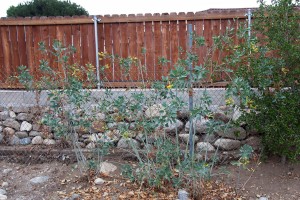Because the BFS ‘Neck’ is long and skinny, with a lot of “edge” relative to its area, non-native ornamental plants have entered the Neck from adjacent yards, and at last Saturday’s workday, volunteers removed a number of these invading plants from the lower part of the Neck.
One target was a sizeable stand of Century Plants (Agave americana):
These large, blue-gray, spiky Mexican natives grow well in Southern California, where they are commonly used as accent plants in the landscape. When a plant is 10–30 years old (“century” is an exaggeration), it produces a tall flowering spike and then dies, but produces “pups” – new plants that arise from the roots. Just a few years ago, the two plants in the Neck flowered (you can see the two tall stalks in the photo above), and there is now a thicket of Century Plants displacing the native flora.
The volunteers began by digging up small plants, then cutting off leaves of larger ones and digging up their roots.
Once smaller plants were removed smaller plants from the edge of the stand, holes were drilled in the “hearts” of the larger plants with a cordless power drill with a really long bit. The idea is that the holes allow the inside of the plant to become infected, and the infection eventually rots the entire rosette. This is the first time we’ve tried this method at the BFS. We’ll let you know how it works!
Volunteers also removed some Cereus sp. cactus growing next to the road.
These large, columnar cacti are native to South America. Their sculptural form and lovely night-blooming flowers make them attractive landscape plants. At the BFS, however, they are spreading and displacing native plants.
Volunteers cut the off the stems, then dug up the roots.
When they were done, there was nary a Cereus to be seen.
The volunteers also dug up several Castor Bean (Ricinus communis) plants growing next to the fence. Castor Beans, which are native to warm parts of Asia and Africa, make interesting landscape plants, but they are highly poisonous, especially the seeds. The poison is not only toxic to humans, but also to animals ranging from cattle and horses to cats, dogs, rabbits, gophers, chickens, ducks, and even aphids and nematodes! Not something we want at the BFS!
Tree Tobaccos (Nicotiana glauca) were the last non-native plants removed by the volunteers. Native to South American, Tree Tobacco is drought resistant, tolerates of a wide range of environmental conditions, and can outcompete native vegetation, often forming monospecific stands. Tree Tobacco also produces nicotine and other alkaloids that are toxic to grazing animals (and people!).
The Tree Tobacco must have been cut back in the past, as it turned out that a number of those apparent small trees were sprouting from a very large stump, which we’ll need to remove on another day…
Lastly, volunteers picked up some very old (pre-field station) trash, including old bottles, broken glass, rusty cans, old upholstery springs (!), a tricycle seat (!), tarpaper, old bricks, pottery shards, etc.
Our next workday – the last for this semester – will be Saturday, December 7. We hope you can join us!
